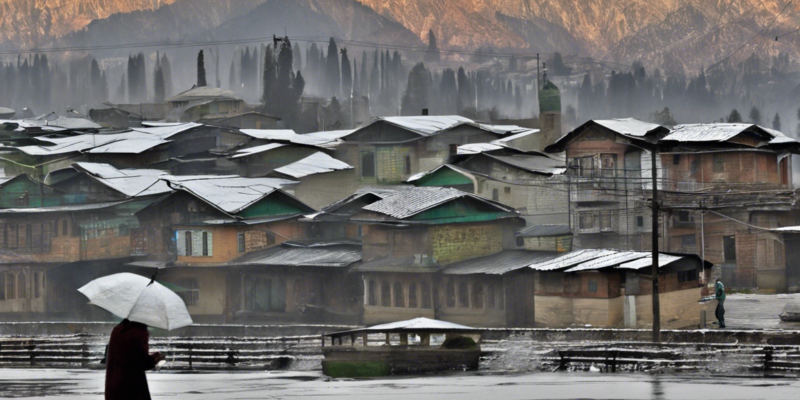Srinagar, the picturesque capital of Jammu and Kashmir in northern India, is known for its breathtaking landscapes, including serene lakes, lush gardens, and majestic mountains. The weather in Srinagar exhibits distinct characteristics throughout the year, making it essential for visitors to plan their trip accordingly. Understanding the climate patterns can help travelers make the most of their experience in this stunning region. Let’s delve into a comprehensive guide to Srinagar weather.
Understanding Srinagar’s Climate
Seasons in Srinagar:
Srinagar experiences four distinct seasons:
– Spring (March to May): Spring in Srinagar is characterized by mild temperatures, blooming flowers, and lush greenery. This is considered an ideal time to visit, with temperatures ranging from 14°C to 25°C.
– Summer (June to August): Summers in Srinagar are pleasant, with temperatures ranging from 15°C to 30°C. The weather is enjoyable, making it a popular time for tourists to indulge in outdoor activities.
– Autumn (September to November): Autumn brings a splash of colors to the region as the leaves change, creating a mesmerizing landscape. Temperatures range from 6°C to 23°C during this time.
– Winter (December to February): Winters in Srinagar are cold, with temperatures often dropping below freezing. Snowfall is common, especially in higher altitudes, and temperatures can range from -2°C to 12°C.
Monsoon in Srinagar:
Srinagar receives monsoon rainfall from July to September, with August being the wettest month. While the rainfall is moderate, it can impact travel plans, so it’s essential to be prepared for occasional showers during this time.
What to Pack for Srinagar:
Spring and Summer:
- Light cotton clothes
- Sunglasses and a hat
- Sunscreen
- Comfortable walking shoes
- Light jacket or sweater for cooler evenings
Autumn and Winter:
- Heavy woolens, including thermals, sweaters, and jackets
- Scarves, gloves, and woolen caps
- Snow boots for winter sports or trekking
- Umbrella or raincoat for monsoon season
Best Time to Visit Srinagar:
The best time to visit Srinagar is during the spring and summer months (March to August) when the weather is pleasant, and the gardens are in full bloom. However, if you enjoy snowfall and winter activities, visiting in December or January can provide a unique and magical experience.
Weather Activities in Srinagar:
Spring and Summer:
- Shikara Ride on Dal Lake: Explore the serene Dal Lake on a traditional Shikara boat.
- Visit Mughal Gardens: Admire the beauty of the Nishat Bagh and Shalimar Bagh gardens.
- Trekking in the Himalayas: Embark on scenic treks in the surrounding Himalayan ranges.
Autumn and Winter:
- Skiing in Gulmarg: Experience world-class skiing in the nearby town of Gulmarg.
- Stay in a Houseboat: Enjoy a cozy stay in a floating houseboat on Dal Lake.
- Explore Old Srinagar: Wander through the historic streets and markets of the city.
Frequently Asked Questions (FAQs):
1. Is it safe to visit Srinagar?
- Srinagar is generally safe for tourists, but it’s recommended to stay updated on the current security situation before planning your trip.
2. Are there any travel restrictions in Srinagar?
- Travel restrictions may be imposed during periods of political unrest or security concerns. It’s advisable to check with local authorities before traveling.
3. What is the famous cuisine of Srinagar?
- Kashmiri cuisine is renowned for dishes like Rogan Josh, Yakhni, and Wazwan, which are a must-try for visitors.
4. Can I see snow in Srinagar?
- Yes, Srinagar receives snowfall during the winter months, especially in the higher altitudes, offering a magical winter wonderland experience.
5. Are there any festivals in Srinagar worth attending?
- The Tulip Festival held in April showcasing the colorful blooms at Indira Gandhi Memorial Garden is a major draw for tourists.
6. How is the connectivity in Srinagar?
- Srinagar is well-connected by air, road, and even a picturesque train route from Jammu, offering various options for traveling to the city.
7. What outdoor activities are popular in Srinagar?
- Shikara rides, trekking, skiing in Gulmarg, and golfing at the picturesque Royal Springs Golf Course are popular outdoor activities in Srinagar.
8. Is it necessary to acclimatize when visiting Srinagar?
- If you are arriving from lower altitudes, it’s advisable to acclimatize slowly to prevent altitude sickness, especially if you plan to visit higher areas like Gulmarg.
9. Can I visit Srinagar during monsoon season?
- While monsoon season in Srinagar can lead to occasional showers, it’s still possible to visit during this time as long as you are prepared for some rain.
10. What are some off-the-beaten-path attractions in Srinagar?
- Dachigam National Park, Shankaracharya Hill, and Pari Mahal are lesser-known attractions in Srinagar worth exploring for a unique experience.
Final Thoughts:
Understanding the seasonal variations and weather patterns in Srinagar can significantly enhance your travel experience in this stunning destination. Whether you prefer blooming gardens in spring, outdoor adventures in summer, vibrant foliage in autumn, or snow-capped landscapes in winter, Srinagar offers something for every type of traveler. By packing appropriately, planning your visit during the ideal season, and being prepared for the occasional rain or snow, you can make the most of your trip to this captivating city nestled in the breathtaking Kashmir Valley.


